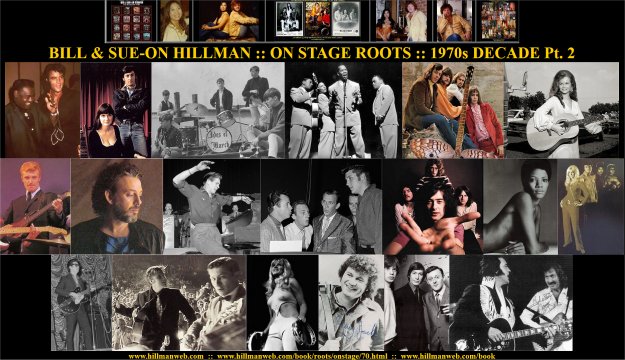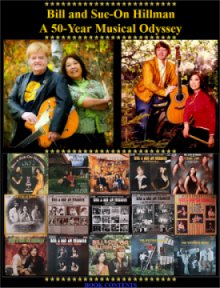English
Roots
Enter Alan Jones again. Al
made periodic visits back to visit family in Northern England and during
a 1996 trip he visited Burrow-Hunter, a booking agency in Middlesbrough.
England's NE was a hotbed of musicians and clubs -- mainly scores of Working
Man Clubs that featured nightly entertainment. He made inquiries on our
behalf and before long we were booked to do nightly shows in 30 different
clubs in that part of England.
Our keyboardist Kevin Pahl agreed to join us and Alan
would play with us in the clubs that had a house organ. This was very exciting
since my appreciation of English music went all the way back to trad jazz,
Lonnie Donegan skiffle and blues, Shadows guitar numbers . . . and the
British Invasion groups. . . especially the Beatles. Much of our
repertoire had been learned from imported Donegan, Shadows and Beatles
records. We reserved our flight.
Drug
Lords
To pay for our flight to England
we kept up a heavy schedule of bookings right up to flight time. A very
demanding set of bookings. In the three days before we took a 747 out of
Winnipeg airport we played across three provinces: Saskatchewan, Ontario,
and Manitoba.
The Saskatchewan booking was our annual Grad dance
in Wapella -- an upstairs hall above their library. They always expected
us to play the "rain dance" during which they all tried to collapse the
weakened floor into the library below by jumping up and down. The hall
survived another year.
The Ontario booking was in Fort Francis after which
we naively took a southern route home which looped through the USA. The
Customs guys were very leery of musicians and since the three of us were
also teachers they thought this must be a cover and we must be part of
some drug cartel. The gung-ho Customs official made us unload all our gear
for inspection. Not only that, we had to unscrew the backs of all our speaker
cabinets to aid them in their search -- hundreds of screws. Eventually
their search proved fruitless . . . and pointless. . . and they disappointedly
waved us on to the next gig.
We played that night in St. Claude, MB -- another grad
dance. We were then poised to begin our overseas adventure.
Culture
Shock
http://www.hillmanweb.com/cards/uk/76bandall.jpg
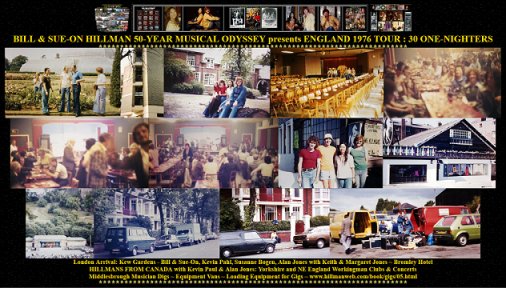 The England we saw as our 747 set down at Heatherow wasn't
quite what we expected. Where was the greenery? England was experiencing
a serious drought and much of the vegetation was dry and parched.
We were met by Alan's brother Keith and wife Margaret. They had rented
a Commer van -- similar to the one that the Beatles took to Hamburg a decade
ago. Their hospitality made our arrival and stay in this foreign country
so much easier.
The England we saw as our 747 set down at Heatherow wasn't
quite what we expected. Where was the greenery? England was experiencing
a serious drought and much of the vegetation was dry and parched.
We were met by Alan's brother Keith and wife Margaret. They had rented
a Commer van -- similar to the one that the Beatles took to Hamburg a decade
ago. Their hospitality made our arrival and stay in this foreign country
so much easier.
Before checking into a hotel they took us on a tour
of Kew Gardens. We then travelled 10 miles south east of London to book
rooms in Bromley Court Hotel, Bromley, Kent. These lodgings were close
to Wing Music, where we were to pick up our equipment the next morning.
I was thrilled to learn that Bromley was famous for three of my main interests.
Science Fiction writer H. G. Wells was born there. Charles Darwin wrote
his Origin of the Species in his Bromley home -- Downe House --
a Heritage building that is a major tourist attraction. The town is also
noted for giving birth to famous entertainers, including David Bowie, Peter
Frampton, Michael York, and numerous Punk musicians.
Taking
Wings to the North
Toronto's Traynor Amplifiers had
agreed to be partial sponsors for our tour. They had contacted Wing Music
in Bromley who were to supply us with amps, PA, drums and keys. Our visit
to the Wing Music store was a bit of a shock. The management were very
obliging, but the building was rather small, very unkept and was packed
floor to ceiling with music gear.
Wing appeared to be second home to a strange group
of musicians who sported extreme haircuts, garbled speech, wicked grooming
and down-dressed wardrobes in the style we would later identify as Punk.
Indeed, the store was home-base to a whole slate of punk artists whose
appearance and music would soon be known worldwide: The Bromley Contingent,
Billy Idol, Siouxie Sioux, Mick Jones of Clash, and the Sex Pistols. The
Pistols were the anarchist punk band which went on to inspire a generation.
Johnny Rotten, Sid Vicious, Steve Jones and Paul Cook took the world and
Bromley by storm in the late 1970s.
We dragged out the gear we would use almost every night
for the next six weeks: Yamaha Twin for bass, two Traynor Twins, electrostatic
mics, Rogers drums, an HH PA head, and huge Traynor speaker columns with
horns. There was no Fender Rhodes piano so we rented a Hohner Clavinet.
After packing the equipment in the Commer, the seven of us somehow managed
to squeeze into the vehicle. Our over-packed van then headed north up the
M-7 Motorway to Middlesbrough where we were to play that night.
Rockin'
and Rollin' and Reelin' in Yorkshire
www.hillmanweb.com/cards/70/uk1all.jpg
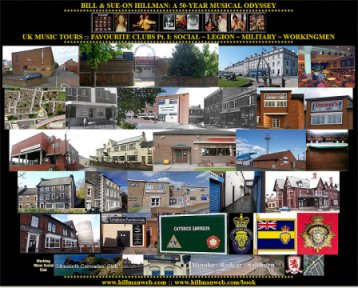 Our original song, Reelin' in Soho, is an account
of our first recording session in London, England. As suggested in the
first verse, this was the culmination of a tour in which we -- The Hillmans
From Canada -- had played 30 one-nighters in social clubs, Legions,
and military bases across Northern England. Many nights found us in the
ubiquitous Workingmen Clubs where a house band opened at 7:00 pm, followed
by opening acts which usually offered variety entertainment. We would then
come on for a show set, after which there would be a long break for housie
(bingo) -- a national addiction.
Our original song, Reelin' in Soho, is an account
of our first recording session in London, England. As suggested in the
first verse, this was the culmination of a tour in which we -- The Hillmans
From Canada -- had played 30 one-nighters in social clubs, Legions,
and military bases across Northern England. Many nights found us in the
ubiquitous Workingmen Clubs where a house band opened at 7:00 pm, followed
by opening acts which usually offered variety entertainment. We would then
come on for a show set, after which there would be a long break for housie
(bingo) -- a national addiction.
After this exciting gambling break we would return
for a dance set - but by 11:00 pm the dancers would call it a night since
they had to work the next day. Being so used to the long drives, long gigs
and late nights back in Canada, it was hard for us to wind down so suddenly
and every night found us driving around looking for some place which might
still be open -- usually Greek or Indian restaurants. We met some very
colourful characters on these midnight rambles.
Geordie
Cowboys
The audiences attended these clubs
every night of the week and had seen it all, so it was especially rewarding
to be so well received. It was tremendously exciting to study the dressing
room walls which were festooned with pictures, cards and stickers left
by previous entertainers -- even the Beatles, early in their careers, had
toured this circuit. These backstage walls were seldom refurbished since
it seemed that the more 'name' acts displayed, the more prestigious the
club. Perhaps the most fascinating venues though, were the Country and
Western Clubs where nearly everyone showed up in full Western regalia -
including boots, hats, gunbelts... and western drawls - Geordie cowboys.
Bombing
the Order of the Buffalo
Our first gig in England was a template
for most of the 30 gigs to follow. Because of the unusual heat wave
and lack of air conditioning it was a bit of a struggle to move our equipment
upstairs to the RMOB club (Royal Antediluvian Order of Buffaloes). The
club seated hundreds of people sitting along rows of square tables and
around small round tables just large enough to hold a ring of pints from
the bar.
The show opened with the house organist, followed by
a variety act, after which we did a show. There was a break for housie
(90 ball bingo) after which we did a dance set and the hall was cleared
out around 11. Most of the patrons came in for a pint or two, enjoyed the
entertainment, played housie, danced and then headed for home for a good
night's sleep -- many of them worked in factories. Everything was new and
strange for us.
We met with a few setbacks setting up: no batteries
for the mics, a wobbly snare stand for Sue-On, and trying to adapt to Kevin's
Hohner Clavinet and keyboard bass (Wing Music couldn't supply a Fender
Rhodes keyboard to augment the Clavie -- I had brought our Hohner Bass
keyboard from Canada). But we soon got into the spirit of the club and
were excited by the enthusiastic handclapping and footstomping reaction
from the drinkers and dancers. We felt crushed when the manager exclaimed
after the show that we "went down a bomb." But apparently to "bomb" had
the opposite meaning there than it did back home. Whew!!!
Eruption
at the Vipond Digs
We were fortunate to find a short-term
boarding house run by entertainers, The Viponds, that catered to musicians.
It was a wonderful experience rubbing shoulders with such a steady stream
of experienced English entertainers.
Al Jones shared a room with an all-black band that
lived up to their name: Eruption. They later had a major hit with the re-make
of I Can't Stand the Rain. One day I gave a Shadows-style guitar
band a lift to a club where The Searchers were playing. There were musicians
who had backed up early rock great Vince Eager. Others had been on shows
with Lonnie Donegan and the local acapello group, Prelude, who had a major
hit with Neil Young's
After the Gold Rush. A dumpy, grouchy old
man staying down the hall wasn't too approachable -- had a habit of kicking
the Vipond's dog. It was only later we were shocked to learn that we had
missed the opportunity of reaching out to UK rock legend, Wee Willie Harris!
But we really felt at home there -- almost everyone
had a musician's mentality and sense of humour and there was constant show
biz chatter and the playing of practical jokes.
In
Search of the Searchers
We have an interesting story concerning
our only brush with the popular Searchers band during one of our England
tours. In our musicians digs in Middlesbrough we had some good guitar jams
with a Shadows wannabe band: Gable and Clark. One day they were excited
about playing at a club across town, but needed a ride since their van
had broken down. Our equipment was already set up in preparation for our
evening gig so I had time to drive them over to the club.
Upon arrival we walked in to a huge crowd that had
already gathered. Then we noticed the marquee and posters: "Tonight: The
Sensational Searchers". The guys queried management and learned that the
club where they were booked had a similar name a few blocks over. A very
embarrassed band then directed me to a much smaller . . . and much less
exciting venue, at a Workingmans Club. We only had a short humorous visit
with The Searchers and didn't even have time to hear them play. We
didn't even hear Gable and Clark in action, since we had to rush away to
our own gig that night.
Following
Dracula's Steps
We played a function for a football
club at Whitby -- the famous port from where Captain Cook launched his
voyages. It is also famous for the 199 stone steps leading up to the Abbey
ruins. These were the steps described in Bram Stoker's Dracula,
the ones that Drac in the shape of a hound had run up after first reaching
England. We played at the Whitehorse Inn and were proud to see our "Hillmans
from Canada" posters displayed all around the area.
Outlaw
Ramblin' Band
Not far from the hotel we played
in Whitby was a large Country and Western club where we saw our posters
displayed along with ones announcing the coming apppearance of famous rocker
P.J. Proby. Proby's claim to fame included a notorious trousers splitting
incident that led to his being banned in certain places.
The C/W club encouraged their dance patrons to wear
full western gear, complete with Stetsons, boots, spurs, chaps and gunbelts.
In fact, the country seemed to show a real fascination with western lore
and country music -- a thirst that hadn't been fully quenched by
many of the English artists. This played to our advantage.
We specialized in a style of country rock and spoke
in "American" accents. At first the audiences were leery of the accents
associated with "Yanks" whom some of them loved to hate, but when we assured
them we were from "the colonies" everything was OK, we were part of the
family. We share some of the excitement of these performances in our song
Outlaw
Ramblin' Band.
Give
Me A Kiss Sweetie
The only hostile crowd we encountered
during our many gigs in England was at a British Legion Club. Friends of
a very obese retarded man, who was waddle-"dancing" in the aisles, encouraged
him to go closer to the stage. They were determined that Sue-On and Kevin's
girlfriend, Susanne, should allow him to stumble onto our stage and give
them a kiss.
Looking down at the drooling, leering person I decided
that it wouldn't be appropriate and tried to handle the situation diplomatically.
We gave the man an autographed album, but the crowd was not appeased. The
mob pleaded and cajoled and became very obnoxious. The "Time Gentlemen
Please" call from the bar brought a sense of relief.
Riding
Traynors Through Scotland
On our first UK tour we were booked
seven days a week for almost seven weeks -- a different club every night.
We made the most of our day-time hours by exploring castles, museums, pubs,
countryside and all the attractions the area had to offer. I did all the
driving since Kevin was not yet 21 and couldn't get an International Drivers
License -- even though he could fly aircraft, since he was a crop duster
and had a pilot's license.
We carried our equipment with us each day so we would
be prepared to drive to the clubs to set up after our all-day tourist jaunts.
Another reason for carrying the equipment was that there were no seats
in the back of the van and our large speaker bins doubled as seats. We
were sponsored by Traynor Amps of Canada and our PA and guitar amps were
gargantuan compared to the much more compact -- and more powerful -- equipment
used by the local bands. Our gear was built for the larger vehicles, stages
and stairways common in Canada.
We were excited to hear one weekend that we had a Sunday
off. We took advantage of the free time by travelling to Scotland around
Loch Ness where we waded into the water in an unsuccessful search for Nessie.
The highlands which were home to my ancestors reminded us very much of
Canada.
We visited the Wartime Memorial Book room at Edinburgh
Castle where a different page was on view each day. By eerie coincidence
the featured page that day contained the name of my Uncle Bill Campbell,
whose Lancaster went down in the closing days of World War II. Years later
the RAF and British Legion invited my mother and me to unveil a monument
in his honour while the Memorial Lanc and Spit flew in tribute formation
overhead. We spent the night in Scotland and rushed south the next day
to start another round of shows.
All
Creatures Great and Small
A memorable gig was in Thirsk --
which actually served as the fictional Darrowby in the popular James Herriot
All
Creatues Great and Small books and TV series. We arrived early enough
to visit the Alf Wight (aka James Herriot) Surgery and to tour a small
museum down the street which displayed instruments and treatments used
by vets through the years. We eventually found Thirsk-Sowerby -- a country
club outside of the village surrounded by a meadow.
What
a Honeymoon
www.hillmanweb.com/cards/70/herriotall.jpg
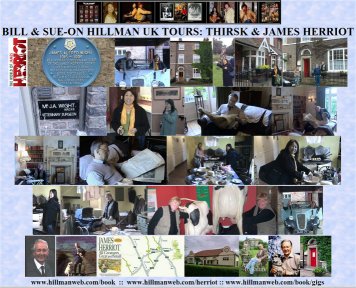 An entertainer hired as our opening act in Thirsk had
been married up north that afternoon and the whole wedding party showed
up at the club. The gig turned very festive. We did our show and dance
and by the usual closing time the party had just begun. The manager locked
the doors so we wouldn't be bothered by the local Bobbies and the party
carried on.
An entertainer hired as our opening act in Thirsk had
been married up north that afternoon and the whole wedding party showed
up at the club. The gig turned very festive. We did our show and dance
and by the usual closing time the party had just begun. The manager locked
the doors so we wouldn't be bothered by the local Bobbies and the party
carried on.
The groom and even our booking agent took turns pounding
Sue-On's drums. The dancers pranced and sang. We played into the wee hours
-- probably the most exciting wedding party we've ever played -- certainly
the most unusual.
Thirty years later, while making a stop on our return
from attending the Phil Collins' Tarzan Musical
premiere in Holland,
our friends the Sandbrooks took us back to Thirsk for old times sake. The
large house that had been the location of James Herriot's surgery
-- the famous
All Creatures Great and Small
veterinarian, had been
converted into a wonderful museum honouring the life and accomplishments
of the now deceased Alf Wight. We spent many hours exploring the rooms
and exhibits and featured most of the photos we took on our Website.
http://www.hillmanweb.com/cards/travel/jamesherriotall.jpg
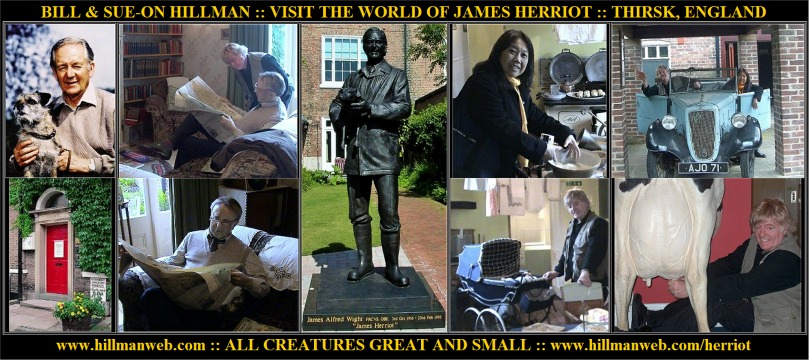
Whatcha
Say Yank?
We have many fond memories of the
colourful people we've met on our English tours -- and we formed many wonderful
friendships. While giving a very friendly gentleman a ride home after a
show we learned that he, like so many men of his age, was a WWII veteran.
He had been part of an air force mission to drop a tin leg to RAF ace Douglas
Bader in a German POW camp.
During a show at New Marske a very friendly pretty
young girl in the audience became quite excited when she learned we were
Canadian and all through the night we heard constant shouts of "I'm
CanAAYdYan too. I'm from CheeAtum!" Some time after our return to
Canada we couldn't believe it when we heard the same voice and exclamation
on a Canadian CTV game show from Toronto: "I'm from Cheeatum. . . I'm from
Cheeatum!" (Chatham, ON) -- it was the same girl.
We sometimes ran into a language problem. Many of the
accents of the locals seemed to change every 10 miles or so. These accents,
coupled with regional colloquialisms and spoken by patrons who had downed
a few drinks too many, often made conversation difficult. At the Excelsior
Club in High Spen we were shocked to hear what had to be a Cajun accent.
It came from a guy from Southern Louisiana, who had moved here after marrying
a Geordie girl many years ago. Even after all those years surrounded by
all-things-English, he managed to hold on to his accent from the swamps
and bayous of Loosiana.
London
Blitz
www.hillmanweb.com/cards/sue-on/sue-onukall.jpg
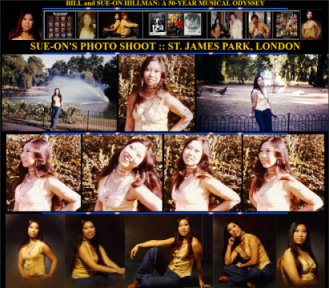 We
met English musician Mick Sandbrook near the end of our first 30-day tour
of Northern England clubs. Mick was to become a true friend and a major
help in our future UK tours and recording sessions. He and his wife Margaret
visited us a few years later and Mick played bass with us on some of our
Manitoba gigs. Mick and a buddy volunteered to drive us and our gear down
to the South, where we had to return the instruments to Wing Music in Bromley,
Kent.
We
met English musician Mick Sandbrook near the end of our first 30-day tour
of Northern England clubs. Mick was to become a true friend and a major
help in our future UK tours and recording sessions. He and his wife Margaret
visited us a few years later and Mick played bass with us on some of our
Manitoba gigs. Mick and a buddy volunteered to drive us and our gear down
to the South, where we had to return the instruments to Wing Music in Bromley,
Kent.
We booked rooms for a week at Mrs. Meanie's guest house
in Bromley from where we rode trains into London each day. There was a
small fish 'n' chips shop near Bromley Station and it became a regular
routine to munch these newspaper-wrapped greasy delights as we rode the
train into Charing Cross Station. Al Jones had lived in London during his
physiotherapy training and, despite being blind, he knew the city and the
tube system perhaps better than most London natives. He was an excellent
tour guide and we hit all the famous spots, exploring music and book shops
along the way.
Thanks to the Beatles and British Music boom of the
'60s so many of the London place names were magic in our minds and we visited
them all: Carnaby, Hyde Park, Palladium, Baker Street, Soho, Chelsea, Pettycoat
Lane, Ronnie Scott's, Thames tours,
Mousetrap, Tower of London,
Buckingham Palace, HMS Belfast, Tower Bridge, Big Ben . . . and we ate
at many Chinese restaurants that were owned by Chinese people from Sue-On's
village in Southern China.
A memorable show we saw at the London Palladium featured
Johnny Ray, Billy Daniels, The Ink Spots, Frances Faye, and supporting
acts. We were regaled with a long string of hits that had defined pop music
through the first three quarters of the century -- "Cry" ~ "Just Walkin'
in the Rain" ~ "That Old Black Magic" ~ "If I Didn't Care" ~ "My Prayer"
-- artists, styles and songs that had inspired so many other singers, including
even Elvis and the Beatles. While enjoying the succession of performers
appearing in this venerable hall, we couldn't help but wish we had been
able to see the Beatles on this stage when they appeared there a little
over a decade previously.
When we mentioned to my dad that we had toured HMS
Belfast docked in the Thames he recalled that this same ship had been in
the UK/US/Canadian convoy that his ship HMCS Prince Robert was part of
in WWII. Their mission was to free Canadian POWs and accept the Jap surrender
at Hong Kong. Photos and description of dad's experiences are presented
on our Website.
We took many photos on these jaunts around London --
many of them we hoped to use for our UK albums and for various promotions
back home. We found unusual leather vests and jackets in a little specialty
shop off Oxford Street. They were actually made of patches of chamois sewn
together. These unique outfits became our stage favourites for a number
of years. Sue-On even wore the vest for a photo shoot in St. James Park
-- a beautiful spot close to Buckingham Palace.
Picking
Gooseberries in Chinatown
When not exploring London's famous
landmarks I scouted the famed Denmark Street area's thriving music production
scene. There were a mulitude of great guitar shops but I was more interested
in the recording studios and publishing houses. While asking about recording
rates I was given tours of the famous recording studios that had hosted
unforgettable sessions by the Stones, Hendrix, Jimmy Page, Donovan, and
many more. The studio layouts and equipment were very different from what
we were used to in Canada. The control rooms in many of them were above
the main floor in sort of a loft overlooking the floor. And of course the
musicians' gear and recording equipment were quite foreign. They seemed
intrigued by our experiences in the colonies and were fascinated with our
country rock stuff -- a genre not well known in the UK at that time.
Some of the guys in the studios knew, or had heard
of, Abbey Road Studio's John Smith, who had engineered our last session
back in Winnipeg. Smith's claim to fame was having worked on The Beatles'
White
Album -- and his name is included in the album credits. Most of them
were on a first-name basis with many of the top rockers who had recorded
in these studios over the last 10 years. Many shared stories -- great stuff
I hadn't heard till then or since.
Just as interesting were the record company execs I
had meetings with in various offices scattered around the area. Alan Jones
had sent a demo tape to David Barnes of Essex Music who met with us two
times. He made some intriguing offers, but eventually we decided not to
follow up on them. We were left with many decisions to make -- the most
difficult involved leaving our day-jobs, teaching careers back in Canada.
Number one on our list was to do some recording.
I had difficulty in choosing a recording studio until at the end of the
second day, back in our guest house, I saw a promising ad in Melody Maker
magazine. Any studio with a name like Gooseberry and was located in Soho's
Chinatown would have to have something unique to offer! I phoned them next
day -- they were cheap, had a 16-track board, and could provide a couple
of experienced session guys. The studio had produced some reggae and dance
hits -- and had recently recorded The Sex Pistols ("God Save the Queen",
"Anarchy in the UK", etc.). It was time to rehearse.
Shameless
Name-Dropping:
Dick James, Robin Hood, George
Martin, The Beatles and Elton John
The most interesting meetings I
had in London's "Tin Pan Alley" around Denmark Street came from a chance
meeting with music mogul Dick James. Passing by what I thought was a bank
building, I noticed a sign that made mention of EMI -- a company well known
to any Beatles fan. I brazenly and naively entered and was directed to
an office on the third floor. I explained to the receptionist that I was
a songwriter/musician and my wife and I had done much performing and recording
in Canada and USA.
Almost immediately I was ushered into the office of
Dick James. I gave my spiel, he played a few songs, we chatted, I left
our records with him, and he invited me to come back the next day. I obviously
hadn't done my homework, since I learned later just how important this
man was. In his early days James had sung the theme for the '50s
TV hit, Robin Hood, which was produced by George Martin. Martin later introduced
him to the Beatles and he notoriously set up and took control of most of
the Lennon-McCartney catalogue through Northern Songs. He later discovered
Elton John, but by the time of our meeting Elton had formed Rocket Records
and was suing James to get out of his contract.
Dick James Music was probably the most powerful music
company in England, but many of his acts were trying to go elsewhere, being
unhappy with their contracts and about his complete control of their publishing.
This probably was what made it so easy for me to make contact with him
as he was looking for a string of eclectic acts to fill the vacuum created
by the acrimonious departure of Elton John and his numerous other acts
-- troubled times. Unfortunately, by the next day's meeting, Mr. James
had decided that his UK market probably wasn't quite ready for our Canadian
brand of country schlock. It was a great experience, but now I could turn
all my time and energies to planning our recording session.

ALBUM VI: TRACK 15
www.hillmanweb.com/cards/70/uk6all.jpg
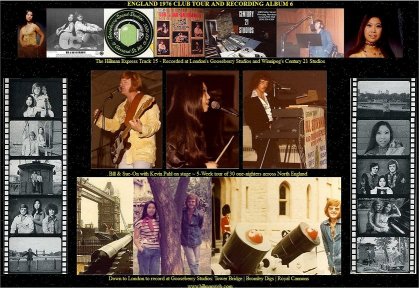
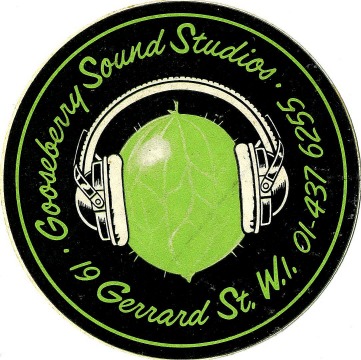
Following
the Sex Pistols into the Depths
In the morning of our first recording
session at Soho's Gooseberry Studios, we carried the gear we had rented
from Wing Music in Bromley to the train, which took us in to Charing Cross
Station. Then we started off in search of a cab carrying my Fender Telecaster,
a Traynor amp, Fender acoustic, Hohner Clavinet, and accessories.
We hailed a cab to take us to Gooseberry Studios on
Gerrard Street, but accents got in the way and the cabbie took us to a
number of wrong locations with similar sounding street names. This seemed
like a legitimate mistake but some London cabbies are known for padding
their fares by taking the longest out-of-the-way routes. We still weren't
sure we were in the right spot when we were finally dropped off on Gerrard.
It t'weren't no Abbey Road.
The entrance to the studio was via a steel fold-up
delivery door in the sidewalk. We started to carry our gear through this
opening, down a ladder into a converted store room and coal bin. Into the
depths of the unknown.
Gooseberry
Studios:
Cavern Studio Below and Tong
Wars Above
After descending into the Gooseberry Studio we saw
a 16-track board that had seen better days. Later we found that it had
only 13 working tracks and most of these were useable only with the help
of chewing gum, rubber bands, and constant spraying and banging. Through
the glass we saw an old piano in the main studio and a set of drums set
up in the adjacent coal bin beyond. Stained mattresses were fastened to
the walls for baffling.
I had brought four rather hurriedly written songs to
the session, two ballads for Sue-On and two uptempo bluesy things for myself.
Alan Jones had one original to record. Gooseberry engineer, Mark Lusardi,
had arranged for two session guys to join us: Joe Fagin on bass and Lloyd
Ryan on drums. In later years we often saw their names in many film and
TV credits. In fact, Joe Fagin sang the theme for popular Judy Dench TV
series, As Time Goes By, seen regularly on PBS in North America.
I played acoustic on some of the bed tracks and to
get sound separation I decided to squeeze into a small dark closet with
guitar and mic. Kevin Pahl played piano on most of the songs, I overdubbed
leads on my Tele, and Al played piano on his original number which Sue-On
sang. The session guys were hot and by the end of the day we had recorded
five unmixed songs. Later, studio time was booked to complete the mix down
to 1/4" tape, which we would take back for release in Canada.
We were in the studio well into the evening and almost
missed the last train back to Bromley. Mark warned us to be careful because
there were some serious Tong Wars going on in the Soho streets above. We
were a strange looking lot on our frantic run through Chinatown, three
guys running behind a Chinese gal with two of the guys taking turns guiding
their blind buddy over curbs and around the late-night drunks sprawled
on the sidewalks. We described this session in our song Reelin' in Soho
which we recorded during a future UK session.
Stompin'
at the American Song Contest
Before we left on our first England
tour I had entered four of my original songs in the American Song contest
in California. It was a bit of an after thought, but there were quite a
number of categories and there was substantial prize money offered -- so
we thought, why not. We were still trying to find a songwriting niche and
recording style so we entered four completely different songs -- songs
that we had often played on our stage shows: Memory Take Me Back, In
Sadness, Massacre, and
Cajun Stomp.
Partway through our tour my mom, who was monitoring
our mail back home, called to tell me that Cajun Stomp had reached
a higher level and the judges wanted the lyrics before they made their
final decisions. We were staying at Vipond's musicians' digs in Middlesbrough
so I rushed down to their lounge to write out the lyrics with covering
letter. The next morning we rushed the letter off to the US.
We had never entered this type of contest -- in fact,
during all our years of playing we had never asked for, or received grants
or any outside financial help. After we returned home we were thrilled
to learn that the song had received a "Runner Up" cash prize and good publicity.
The song was fun to do, so we found a spot for it on our next album and
later performed it on a number of national television specials and award
shows.
Sail
On 747
When it came time to prepare for
our flight home, we found that our luggage was way overweight. Our solution
to this problem was to purchase duffel bags and load them with our two-inch
master tapes, records, UK Tarzan comics, and some of the heavier souvenirs.
These we arranged to have sent to Canada in a cargo ship.
Our feelings on flying home after so many weeks I described
in a song we recorded on a later tour of the UK: Sail On 747 --
a song that has received much airplay over the years. We had a full slate
of fall gigs waiting for us back home as my mother had monitored our mail
and phone calls and passed along info on potential new bookings which we
then confirmed by phone and mail.
We arrived home in time to prepare for another year
of teaching. During my 40 years as a full-time educator, teaching high
school and university courses, I've usually tried to keep my two careers
separate: "What did you do over summer holidays, Mr. Hillman." "Oh,
not too much. We travelled a bit." The following year's UK tour, delivered
even greater culture shocks, as later GIG NOTES and journal entries in
the MEDIA section will reveal.
ALBUM VII: THE NEWCASTLE SESSIONS
www.hillmanweb.com/cards/70/uk7all.jpg
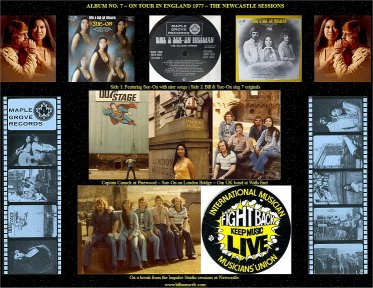
Impulse
Recording at Wallsend -- A Gamble
On our return to Canada we immediately
started planning a second tour of England for the following summer. Throughout
the coming year we kept up correspondence with Mick Sandbrook and he lined
up session muscians and studio time. Tracks which were to make up our seventh
album were recorded at Dave Wood's Impulse Studios at Wallsend (Newcastle-On-Tyne).
It was a small 8-track studio on the third floor above a theatre and bingo
hall in a large heritage building that had showcased countless shows and
famous entertainers over the decades. In fact, local star-to-be, Stan Laurel,
had honed his comedic chops here before heading to Hollywood. Impulse studios
had recorded a respectable lineup of acts, from folk (Lindisfarne) to a
multitude of rock and heavy metal bands from the North East (Sting, Last
Exit, etc.) -- and Dave also claimed to have recorded The Chieftains.
I played guitars, buddy Mick Sandbrook from Middlesbrough
played bass, and we brought in drummer Alan Studholme and pianist Bernie
Watson. Local musician John Ashcroft eked out amazing sounds from his early
model ARP Odyssey and Vox string synths: strings, clavinet, brass, jews
harp, and SFX such as bubbles, flanging and wind.
The session guys learned all 12 songs in the studio
as we recorded them. Between sessions we had some good photo shoots at
Tyne Mouth, the Priory, WWII sites, and along Hadrian's Wall. We used a
few of these photos on the album insert sheet, but the photos for the front
and back covers were taken at Terrence Fowler's studio back in Brandon.
Kevin joined us for the studio photos for which we all wore our ragged
patch-chamois costumes.
While I was busy mixing the tracks with engineer Mickey
Sweeney on the final night, Sue-On decided to help pay for some of the
studio time. She went out to the local casino with the Jones family and
won 38 pounds playing black jack -- not bad for a novice gambler. The dealers
obviously under-estimated her -- thinking she was the Jones's au pair.
As we had done on Album No. 6, we planned No. 7 to
be a double concept package: Side One: Sue-On - The Newcastle Sessions
which featured some of Sue-On's favourite solos and Side Two: Road Songs:
On Tour In England for which I wrote songs inspired by our experiences
on the road, both in North America and in England.
I.
SUE-ON: The Newcastle Sessions
www.hillmanweb.com/cards/sue-on/7pics1all.jpg
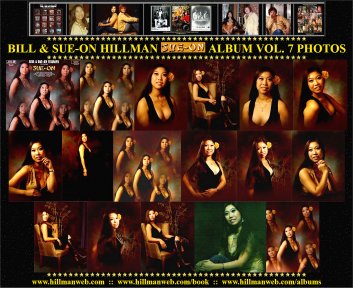 As with most of our albums we chose a number of cover
versions of songs that would appeal to our record-buying fan base who always
look for familiar titles. This allowed us to mix in an equal number of
originals which would get us more radio play and media coverage. We had
done a less than spectacular version of Tiny Bubbles on our first
album. Since that time we had combined it with Paper Roses in our
stage shows. Sue-On was anxious to hear how this medley would sound
from a more acceptable studio. We had a ball doing this one in a shuffle
rhythm and then used the synth to add some "bubble" sound effects to it.
She also did a new version of Silver Threads and Golden Needles.
It turned out to be a much more driving version than the previous album
No. 1 effort.
As with most of our albums we chose a number of cover
versions of songs that would appeal to our record-buying fan base who always
look for familiar titles. This allowed us to mix in an equal number of
originals which would get us more radio play and media coverage. We had
done a less than spectacular version of Tiny Bubbles on our first
album. Since that time we had combined it with Paper Roses in our
stage shows. Sue-On was anxious to hear how this medley would sound
from a more acceptable studio. We had a ball doing this one in a shuffle
rhythm and then used the synth to add some "bubble" sound effects to it.
She also did a new version of Silver Threads and Golden Needles.
It turned out to be a much more driving version than the previous album
No. 1 effort.
Another fan favourite at our shows and dances has been
Please, Release Me. For this one I set the rhythm by using a drumstick
to beat out a percussive sound from my guitar. We have a number of Neil
Diamond songs in our repertoire and we finally settled on his Song Sung
Blue.
When we contacted Neil Diamond to pay royalties for the release
of his composition he requested that we send album covers/inserts. They
were to be added to the display of covers on the walls of his Nashville
office.
www.hillmanweb.com/cards/70/impulseall.jpg
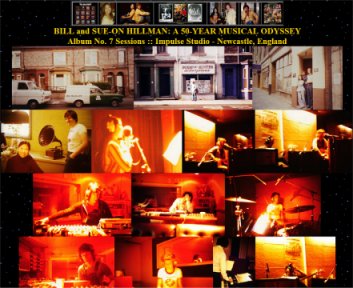 We sing the gospel great, Why Me, Lord? as a duet
on stage. For the studio session, however, Sue-On sang a fantastic solo
and overdubbed harmony parts, a la Mary Ford and Patti Page. Impulse
owner Dave Wood was at the studio while we recorded Why Me Lord?
and was so impressed with it that he immediately took a dub down to the
local radio station. One of the jocks flipped over it and played it three
times on his show. I couldn't help but think back to the memorable event
in Memphis when Sun studio producer Sam Phillips rushed the acetate of
his newly recorded singer, Elvis Presley, over to the local radio station.
DJ Dewey Phillips played the song over and over for listeners who thought
the new singer was black and were surprised when Dewey hinted that the
kid was white. In our case the enthusiastic DJ surprised listeners by revealing
that the singer was a young Chinese girl from Canada. They later
featured the song as a regular on their Sunday religious programmes, as
well. We were pleasantly surprised when
Why Me, Lord? went on to
receive a nice bit of airplay across the UK and Germany.
We sing the gospel great, Why Me, Lord? as a duet
on stage. For the studio session, however, Sue-On sang a fantastic solo
and overdubbed harmony parts, a la Mary Ford and Patti Page. Impulse
owner Dave Wood was at the studio while we recorded Why Me Lord?
and was so impressed with it that he immediately took a dub down to the
local radio station. One of the jocks flipped over it and played it three
times on his show. I couldn't help but think back to the memorable event
in Memphis when Sun studio producer Sam Phillips rushed the acetate of
his newly recorded singer, Elvis Presley, over to the local radio station.
DJ Dewey Phillips played the song over and over for listeners who thought
the new singer was black and were surprised when Dewey hinted that the
kid was white. In our case the enthusiastic DJ surprised listeners by revealing
that the singer was a young Chinese girl from Canada. They later
featured the song as a regular on their Sunday religious programmes, as
well. We were pleasantly surprised when
Why Me, Lord? went on to
receive a nice bit of airplay across the UK and Germany.
II.
ROAD SONGS: On Tour In England
www.hillmanweb.com/cards/70/7pics2all.jpg
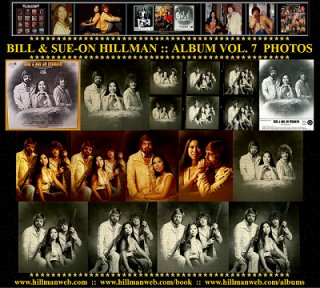 Side Two featured seven more
of our originals - two of them written by Al Jones who had organized and
accompanied us on our first UK tour. Sue-On had recorded the ballad,
While
You're Away, the year before in London's Gooseberry Studios.
Boogie
Woogie Band had come out of the Free Spirit sessions we had done the
year before.
Side Two featured seven more
of our originals - two of them written by Al Jones who had organized and
accompanied us on our first UK tour. Sue-On had recorded the ballad,
While
You're Away, the year before in London's Gooseberry Studios.
Boogie
Woogie Band had come out of the Free Spirit sessions we had done the
year before.
Outlaw Ramblin' Band narrates the events of
the first tour: the rather scary decision to leave the Canadian prairies
to embark on a 30-night tour of English clubs, our first flight in a 747,
the hectic confusion of Heathrow Airport, the crazy London traffic, the
long commute to Northern England in a packed Commer van, and the challenge
of playing for packed Workingman Clubs every night. This involved adapting
to taking the stage after a warm-up variety act and house band intro, playing
a show set, getting off stage while the audience indulged in Housie (Bingo),
and then going on for a dance set, and shutting the whole thing down by
11 o'clock. It also gave us the experience of working with musicians we
had heard about and admired for so long, exploring dressing rooms that
the Beatles had used a few years before, playing up the novelty of our
"American" accents and country/rock-based music, being typical tourists
through the day, and suddenly adapting to Canada again after being immersed
in British culture for seven weeks.
One Night Stand is a sort of wistful reflection
on our many years of performing one-night shows for just about every venue
imaginable. This duet opened many doors for us as it became a Top Ten hit
on many stations and we performed it on network television, the national
Big Country Awards Show, the Opry North Show and shows in various Concert
Halls. It was also instrumental in our receiving the Manitoba Entertainers
of the Year Award, which led to media coverage on the CBC National, newspapers,
magazines and TV/Radio interviews.
Swamp Romp is a bit of a screamer but its main
theme is that we were open to all musical genres and gigs. Over the years
we have performed just about every type of music for all kinds of functions:
military bases, TV/Radio, fairs and rodeos, outdoor festivals, arena shows
and dances, auditoriums, penitentiaries, barn dances, high school proms,
hoedowns, film soundtracks, commercials, churches, weddings, socials, Indian
pow-wows, and festivals: folk, Celtic, blues, cowboy poetry, gospel rock,
bluegrass, etc. ... we love 'em all.
Montana shares the experiences we had while
performing on grandstand shows in US state and county fairs. All of our
tours have been summer tours, taken during our summer break from teaching
high school -- and university classes in our more recent years. Our backgrounds
as geography majors and educators always influenced our appreciation of
the geography and local colour of the places we toured. This fascination
is quite evident in this song.
Good Time Jamboree is a novelty song about
our stage exploits and the experience of performing many decades of one-nighters.
Newcastle's Impulse studio, like so many of the places we played in England,
was inaccessible in the extreme. We had to pull our gear up many flights
of stairs and through a seemingly endless number of doors because the facility
was situated on the upper level of a large bingo hall and theatre complex.
After surviving this ordeal, which anyone in his right mind would have
left to roadies, I returned to re-park our Ford Transit van only to find
that the meter maid had decorated it with a parking ticket - to add infuriation
to fatigue.
James
Bond Out - Superman In
www.hillmanweb.com/cards/70/pinewoodall.jpg
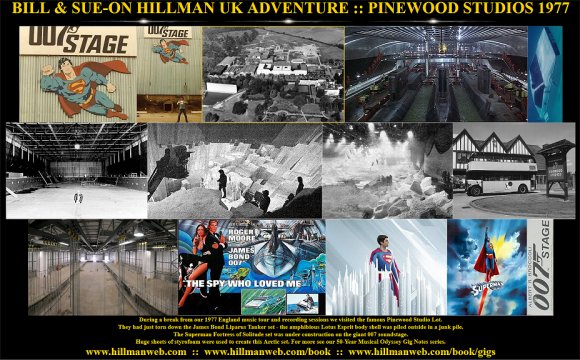 We had a few free days before returning to complete our
recording session with additional vocals and mix, so Mick generously let
us take his small van to the South. We returned to Mrs. Meanie's guest
house in Bromley for our stay. By chance we heard that there was a rare
open-house day at the famed Pinewood Movie Studios. We rushed over by train
and bus and toured the main 007 soundstage where they had just wound up
a James Bond shoot and were bringing in truckloads of white styrofoam to
create an Arctic Fortress of Solitude set for the upcoming Superman movie.
This was to be the most expensive film made to date.
We had a few free days before returning to complete our
recording session with additional vocals and mix, so Mick generously let
us take his small van to the South. We returned to Mrs. Meanie's guest
house in Bromley for our stay. By chance we heard that there was a rare
open-house day at the famed Pinewood Movie Studios. We rushed over by train
and bus and toured the main 007 soundstage where they had just wound up
a James Bond shoot and were bringing in truckloads of white styrofoam to
create an Arctic Fortress of Solitude set for the upcoming Superman movie.
This was to be the most expensive film made to date.
I couldn't resist posing for a photo under the studio's
towering Superman sign. I pulled open my shirt to reveal my maple leaf
T-shirt and assumed a heroic Captain Canuck pose. My hopes of being signed
as a stand-in for Christopher Reeve never materialized : )
This gigantic studio burned down soon after -- but
was rebuilt -- even bigger and better. We had a great time prowling around
the Pinewood backlot and finding many of the props used for the just-completed
James Bond film, including the mock-up shell of his amphibious Lotus Espri.
For this Bond film, The Spy Who Loved Me, a giant 007 soundstage
had been built to replicate the inside of a tanker, the Liparus Tanker
set, at a cost of $1.8 million. Also impressive was the mammoth water tank
that stored 4.5 million litres. The Lotis was thrown out with a pile of
other props. It was later retrieved from the "scrap heap" and was bought
by Elon
Musk for a million dollars.
Another highlight was touring the Avengers offices
and grounds -- locations where Patrick McNee and Diana Rigg had spent so
much film time playing John Steed and Emma Peel.
Whaaa?
You Say The Cavern Club Is Now A Parking Lot?
www.hillmanweb.com/book/gigs/beatlescavernall.jpg
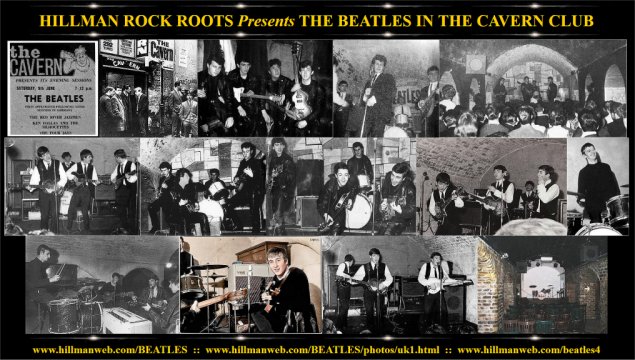 We had a chance to explore Liverpool
-- home of the Beatles and the Mersey Beat -- during our break between
sessions. After being so bombarded by Beatles lore over the years this
was a bit like taking a pilgrimage to Mecca.
We had a chance to explore Liverpool
-- home of the Beatles and the Mersey Beat -- during our break between
sessions. After being so bombarded by Beatles lore over the years this
was a bit like taking a pilgrimage to Mecca.
We were in for a bit of a letdown,
however, during our search for the legendary Cavern Club. All we found
was an empty lot. We asked around and interpreted enough words from the
Merseyside Scouse accents to realize that the building above the Cavern
cellar club had been razed to make way for a much more important parking
lot and subway project. A few years later, realizing their mistake, the
city authorized the conversion of the basement of a similar building nearby
to simulate the original Cavern.
We happened upon one of the few
Macdonalds restaurants we had seen in England at that time and were surprised
by the subtle differences in the food, such as the sweet pickles instead
of dills and the sweet buns they used in the Macs. True to form though,
they offered stringy, greasy little potato things they called "french fries"
-- certainly no match for the wonderful British chips we had lived on almost
daily.
Looking around the restaurant
we were in for another shock. The look of the Sex Pistols, who had recorded
at our Gooseberry studio and who had been such a presence at Wing Music,
seemed to be catching on. All around us were kids who had adopted a look
that soon would become known as Punk: strange haircuts, shaved heads, tattoos,
piercings, grungy baggy clothing, etc. -- it reminded us of sort of a biker
gang wannabe crowd. We never guessed that the the punk movement was poised
to infect the whole Western world. One final shock before making our way
back to London was seeing a poster advertising an appearance of a new artist
who had adopted a bit of a punk look and style, and who had partially adopted
a famous name: Elvis Costello.
Liverpool seemed to want to bury
all references to the Beatles. I never dreamed, though, that I would
have a chance to trace the Beatles trail in Hamburg a few decades later
-- their early 1960s experiences in Hamburg's infamous Reeperbahn district
was the training gauntlet that prepared them for their future successes
in Liverpool, London. . . and beyond. But that's another story - a story
we've documented on our Website.
The
Beatles: Early Years in Hamburg
Shadows'
Jet Harris and the Diamonds . . . and Kenny Rogers
I've been an avid fan of England's
Shadows pretty much since they began in the '50s. It was a thrill to finally
see a one-time Shadows bass player at the Fiesta Club in Stockton. A good
house band, MC and C/W singer played to a full house in this huge show/dance
and disco club. The feature act was early Shadows favourite, Jet Harris,
along with his band, The Diamonds.
Disappointingly, Jet turned out to be a small balding,
spaced out and tipsy bass player, while his lead guitar player did all
the Shadows and Ventures instrumentals. Eventually, Jet ended the set by
playing his hits, Diamonds and Rhythm & Greens on a terribly
out-of-tune guitar. Frightful and very disappointing.
Amusingly, I attracted many stares and questions from
the crowd who were asking if this stranger to the club was Kenny Rogers
from America. They were fooled by my accent, long hair and red beard.
The
King is Dead!
www.hillmanweb.com/book/gigs/elvismemoriesall.jpg
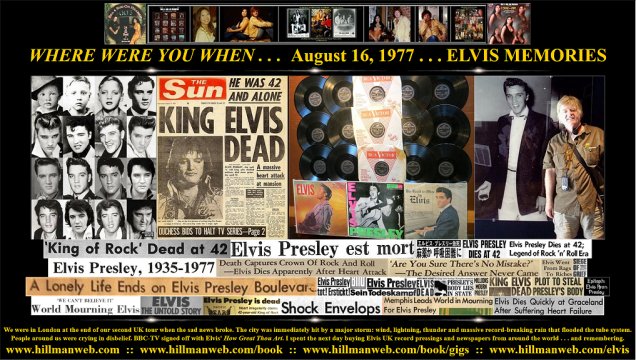 At the end of our second tour we spent a few days roaming
London: Picadilly, Knightsbridge, Harrods, British and Natural History
Museums (75 Years of Recorded Sound Exhibit), Royal Albert Hall, Chinese
restaurants, Palladium, West End plays ("Godspell" and a Glynis Johns play),
Agatha Christie's record-running Mousetrap, and the new Edgar Rice
Burroughs movie in Leiscester Square.
At the end of our second tour we spent a few days roaming
London: Picadilly, Knightsbridge, Harrods, British and Natural History
Museums (75 Years of Recorded Sound Exhibit), Royal Albert Hall, Chinese
restaurants, Palladium, West End plays ("Godspell" and a Glynis Johns play),
Agatha Christie's record-running Mousetrap, and the new Edgar Rice
Burroughs movie in Leiscester Square.
On the last night we returned to our B&B room just
as a terrific storm hit which coincided at 10:30 with shocking news on
the radio -- the death of Elvis Presley. A surreal evening: the hotel keeper
and roomers were crying in grief, thunder and lightning crashed, the storm
flooded the streets and even closed down much of the tube system. To add
to the solemnity of the evening, BBC-TV reverently signed off with Elvis'
How
Great Thou Art.
Fly
Away
On the morning after the news of
Elvis' death we hit the streets of London early. Every newspaper displayed,
"King is Dead" headlines. We bought papers and all the English-pressed
Elvis records I could find before we took a train to Gatwick Airport.
Amazingly, there were three sets of people from Manitoba
in the airport queues who had been to our dances back home. We arrived
home in time to play an outdoor gig at the Rossburn Indian Reserve. There
had been heavy rain all day and the low, makeshift stage was covered with
and surrounded by mud.
We played to a very responsive crowd in fog and wet
and cold. It was fun backing local singers, including the chief who played
fiddle songs. A surreal contrast to the English scene we had left
the day before.
ALBUM IX:
ON STAGE IN ENGLAND
www.hillmanweb.com/cards/70/uk9all.jpg
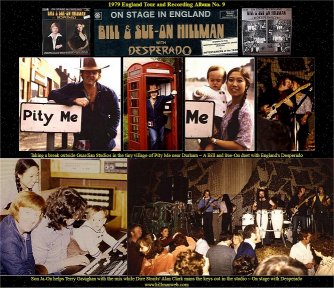
The
Maple Leaf / Union Jack Project
The recording project that came
out of our third tour of the UK was unique. Bassist Mick Sandbrook, who
had played such an important role in our two previous tours, set up a joint
session that would integrate us with his show band, Desperado.
Before moving on to super stardom with Free
and
Bad Company, Paul Rodgers had gotten his start with the guys
in this band. Each member of Desperado sang and the band featured Mick,
John Whittingham and Colon Bradley on bass/guitars, Paul Druckers on drums
and Alun Edwards on percussion.
Both Sue-On and I and Desperado wrote original songs
for the session and we then chose some popular cover songs from our mutual
set lists. Our plan was for all of us to work on the backing tracks and
then for each of us to add our own vocals to two separate mixes, resulting
in almost 20 songs for each group. I wrote five originals and Desperado
wrote three for the session. The material was rehearsed at Workingman Clubs
in the area.
Pity
Me
Terry Gavaghan, a former guitar
player for the Carpenters, built his 24-track Guardian recording
studio in two adjoining row houses in the village of Pity Me, County Durham.
On Terry's recommendation, I hired Alan Clark, one of the top musicians
in the NE, to join us on keys and he arrived with Arp synths, Fender Rhodes
63 and Hohner Clavinet. Alan was a health food freak and filled the studio
with acrid fumes from the strange organic mixtures he smoked. A super musician.
Terry had bought an upright grand piano from the
studio
at Château D'Hierouville, France -- the one that Elton John
had used for songs on the
Honky Chateau and Goodbye Yellow Brick
Road albums. The drums were the battered remains
of Keith Moon's Premier Resonator kit, which Terry had bought at
a London auction. Terry and Moon had been buddies in London and had survived
some pretty wild adventures together.
I led the recording of our bed tracks, while playing
my Telecaster Thinline through a Vox practice amp. Paul had trouble finding
the rhythms for many of our songs so Sue-On took over Moon's drums for
her songs. Desperado's instrumentals and back-up vocals were first class.
I conveyed head arrangements to Alan Clark who did a great job translating
them into full sounds of strings, horns, flutes, saxes, synth effects,
piano and clavinet: a few examples were Creole Horns for Promised Land
and for the Take It Easy ending I even had him work on a 5-string
banjo sound -- demonstrating the rolls and droning fifth string to him.
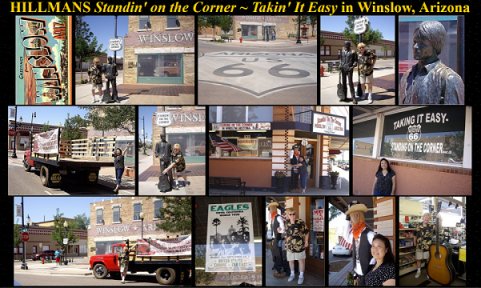
Local
Hero Hits Dire Straits
www.hillmanweb.com/cards/uk/clarkall.jpg
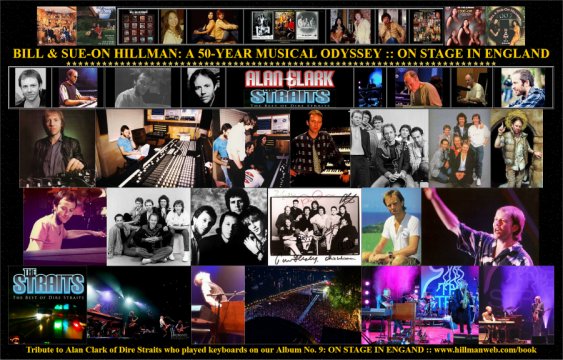 On our many previous recording sessions I had played all
the guitars - multi-tracking acoustic and electric rhythms and guitar leads.
It was a treat then to play with the two hot Desperado guitarists. It was
an even greater thrill to work with Alan Clark who brought an arsenal of
keyboards and a superb knack for laying down arrangements to augment our
bed tracks. For our stage shows we had relied heavily on a Fender Rhodes
piano (an 88-keys model that we split so as to play the bass keys through
bass amp) and a Clavinet, so we requested that Alan bring these instruments
for the session. But he also brought ARP synths which he used to great
effect to add punch and sweetening to the backing tracks and to augment
our triple guitar arrangements.
On our many previous recording sessions I had played all
the guitars - multi-tracking acoustic and electric rhythms and guitar leads.
It was a treat then to play with the two hot Desperado guitarists. It was
an even greater thrill to work with Alan Clark who brought an arsenal of
keyboards and a superb knack for laying down arrangements to augment our
bed tracks. For our stage shows we had relied heavily on a Fender Rhodes
piano (an 88-keys model that we split so as to play the bass keys through
bass amp) and a Clavinet, so we requested that Alan bring these instruments
for the session. But he also brought ARP synths which he used to great
effect to add punch and sweetening to the backing tracks and to augment
our triple guitar arrangements.
We weren't surprised when we heard a few months later
that he had joined Mark Knopfer's Dire Straits - the start of a
long career with that band, until Knopfler went on to a solo career. His
playing became an important element and helped transform the band into
the huge group they then became with albums such as "Brothers In Arms."
Alan was responsible for the lush, melodic arrangements on the Kopfler
soundtrack for the film LOCAL HERO -- one of our all-time favourite films
and albums. He also appeared in this highly acclaimed Burt Lancaster film.
There was a scene where a local Scottish band played for a country dance.
If you look carefully you'll see Alan on stage playing upright piano with
the band.
Alan Clark also did production, session and touring
work with many of the greats such as George Harrison, Sting, Van Morrison,
Elton John, Phil Collins, Bob Dylan and Tina Turner and was on many of
their hits. We had the pleasure of seeing him on two shows many years later
in Canada with Dire Straits and also playing a stack of synths and
Hammond B3 organ in Eric Clapton's band. In recent times he has recruited
many of the former Dire Straits musicians and has formed The
Straits aka The Legends. The band travels worldwide thrilling huge
crowds with all the Dire Straits hits.
Many years later after this session and a few months
before Dire Straits were inducted into the US Rock 'n' Roll Hall of Fame
in 2018, the Rock Hall organizers contacted us. They asked if they could
use our solo photos of Alan Clark in the Dire Stratis induction ceremony.
We, of course agreed and a short time later a contract and a very
generous cheque arrived.
Sue-On and I expectantly tuned into the TV broadcast
which had an audience of millions. Alan represented Mark Knopfler, who
couldn't attend and was called to the stage to accept the Hall of Fame
honour on behalf of the band.
During this time, giant images of our photos of Alan
playing his synths and at the mixing board in the Guardian control room
during our Album 9 sessions appeared on a huge screen behind him. A proud
moment and a thrill for us.
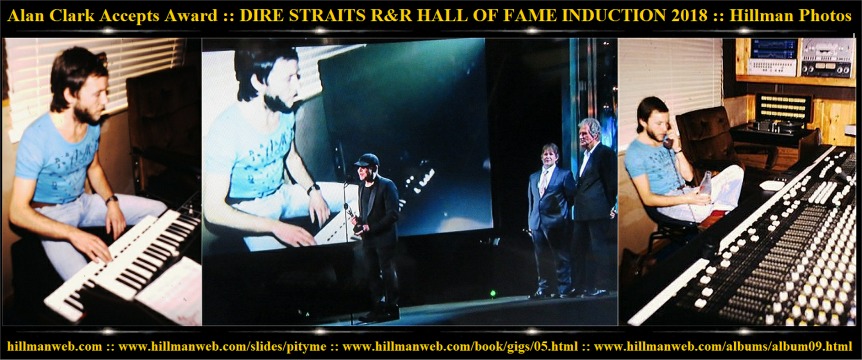
The
Studio Ghost. . . She's Back!?!
We had booked Guardian Studios for
five days with unlimited hours recording time. As a result I spent very
long days and worked well into the wee hours. One night we moved Keith
Moon's drums out of the isolation booth, which also doubled as a vocal
booth.
I had just finished double tracking Lady Luck, Chuck
Berry's R&R Medley and Promised Land and was in the middle
of my Take It Easy vocals. Sue-On had gone across the street to
make a long phone call at the pay phone, so I was alone at the mic. Terry
and Mick were working the board behind the glass.
I had just started the song when a brilliant light
flashed behind me. The guys at the board appeared startled and stopped
the tape. I assumed that some piece of equipment had blown up. Terry motioned
me into the control room and phoned his assistant, Keith, who lived upstairs
above one of the row houses. The guy rushed in saying, "She's back!?!"
The
Haunted Studio
www.hillmanweb.com/slides/pityme
www.hillmanweb.com/cards/70/studioall.jpg
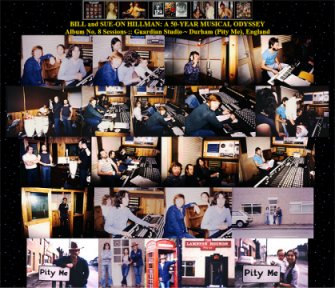 Apparently Mick and Terry had seen the negative image
of a short figure in the brilliant flash of light that had lit up the room
behind me. Terry went on to relay the story of the ghost of an 8-year-old
girl who had been struck by a lorry in the street 30 years ago. Bystanders
had brought her in and laid her on a couch that was situated where the
drum booth now stood. It was there that she died.
Apparently Mick and Terry had seen the negative image
of a short figure in the brilliant flash of light that had lit up the room
behind me. Terry went on to relay the story of the ghost of an 8-year-old
girl who had been struck by a lorry in the street 30 years ago. Bystanders
had brought her in and laid her on a couch that was situated where the
drum booth now stood. It was there that she died.
The girl's ghost was a bit of a legend in the town.
There was even a picture of her in the pub down the street. The legend
was that she usually appeared before a disaster of some sort happened.
She must have been listening to my vocals. Strangely, a few weeks back,
in the middle of the night, Terry and his wife had heard a cry from someone
falling down the stairs from their upstairs suite. The only other person
in the suite was their young son, John, who slept in another room. They
raced out, but found their son still fast asleep in his bed.
On another occasion they awoke to see the glowing figure
of a young girl standing at the foot of their bed. They learned the next
morning that a close relative had died that night. I am not at all superstitious
and have still to be convinced about the validity of the supernatural...
and I didn't see a ghost girl... but there certainly was a brilliant light
behind me that night. We had a good story to tell Sue-On when she returned
from her long phone call.
The
Guardian Legend
Terry Gavaghan
was a well-known studio engineer in the North East, a bit of a local legend.
He had worked on very many of the definitive early punk/new wave releases
that came out of that area in the 1970s and 1980s. He also did a
lot of work for local television.
Terry's Guardian studio
was rather small, occupying just the two ground-floor rooms of the centre
terrace house. The live room had a compact drum booth and upright piano.
The control room was smaller, containing a Studer mixing console and 24-track
recording machine, Terry's studio engineer's chair and an uncomfortable
wooden bench fixed to the back wall, for clients' 'listening-back'. A rear
extension contained a small kitchen and toilet facilities, and an access
door opening directly into the back lane outside, where most loading-in
was done by visiting bands.
Terry's many claims to fame and
his stories, anecdotes and sayings have passed into local music folklore.
Keith
Moon and 'The Gabardine Trousers'
Terry took
pleasure in sharing some of the tall tales that he and The Who wildman,
Keith Moon had experienced in years past. One day between takes
he told us a story of how he, Keith Moon and Vivian Stanshall (of
The
Bonzo Dog Band), played outrageous Pythonesque practical jokes in London
during the early 1970s.
One such tale, 'The Gabardine Trousers' involved Gavaghan
entering the premises of an upmarket Oxford Street tailor, asking to see
a pair of Gabardine trousers. After these were produced, Stanshall entered,
exclaiming "Ah, Gabardine trousers, I must have them!" and a fight would
then ensue between the two, resulting in the pair of trousers being torn
completely in two.
At this point, with the salesman apoplectic, Moon entered
the shop on crutches, with one leg strapped up under his long coat and
a wooden leg. "Ah, one-legged Gabardines!" he cried. "I'll take them both!"
Bringing
Home the Good Times
After completing close to 40 songs
in five days of almost-around-the-clock sessions at Guardian Studios I
had run out of steam and didn't have the time or energy to learn the third
Desperado original, Bring Back the Good Times. The band had already
completed their version. This actually worked out for the best.
Mick brought the 2-inch, 24-track master to Canada
when he visited us the next year. We went to work on it. Sue-On and
I spent some time at adapting Good Times to our style. We turned
this original Desperado solo song into a very powerful, but bitter sweet
and melancholy duet, which we recorded at Century 21 Studios in Winnipeg.
After mixing the song to 1/4 master we decided that
the original song was way long for a planned single release. I went back
to the studio and did a razor blade edit, taking a verse and chorus out
of the master. Somewhere along the way the master tapes were sent to Edmonton
for conversion from Dolby. The single release got good air play and charted.
The song eventually saw album release about 15 years
later on our CD Album No. 10: 24 Original Songs that we collated
in Del Clark's Brandon studio, Century One. The CD was mastered in Toronto
and we took the photos and designed the inserts that were printed locally.
Whew! The beast has a long and involved history.
On
the Road Again
www.hillmanweb.com/cards/70/stageall.jpg
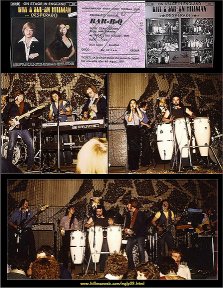 Our final live performance in England was ironically a
good ole Western-style barbeque and barn dance near a military base at
Stokesly. The stage in the huge building was decorated with military camouflage
netting from the nearby base. The performance was for a large lively crowd
-- well fueled with steaks and beer.
Our final live performance in England was ironically a
good ole Western-style barbeque and barn dance near a military base at
Stokesly. The stage in the huge building was decorated with military camouflage
netting from the nearby base. The performance was for a large lively crowd
-- well fueled with steaks and beer.
Sue-On and I and Desperado rocked out many of the songs
we had just recorded. We added some old time rock 'n' roll to the sets:
Memphis,
Baby
What You Want Me To Do, Lawdy Miss Clawdy, It's So Easy ~ Summertime,
and a whole lot of heavy blues.
We were soon homeward bound. England beckoned two more
times, but we would not see the guys in the band until over 30 years later.
Back home we had another album to release, a Manitoba gig schedule to resume
and were about to go through many surprising turns in life and career.

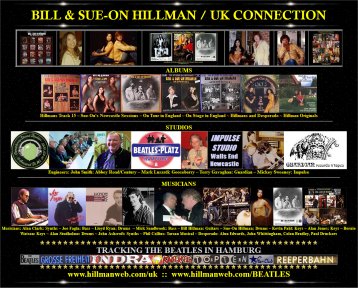
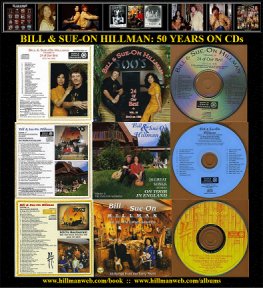




 We
met English musician Mick Sandbrook near the end of our first 30-day tour
of Northern England clubs. Mick was to become a true friend and a major
help in our future UK tours and recording sessions. He and his wife Margaret
visited us a few years later and Mick played bass with us on some of our
Manitoba gigs. Mick and a buddy volunteered to drive us and our gear down
to the South, where we had to return the instruments to Wing Music in Bromley,
Kent.
We
met English musician Mick Sandbrook near the end of our first 30-day tour
of Northern England clubs. Mick was to become a true friend and a major
help in our future UK tours and recording sessions. He and his wife Margaret
visited us a few years later and Mick played bass with us on some of our
Manitoba gigs. Mick and a buddy volunteered to drive us and our gear down
to the South, where we had to return the instruments to Wing Music in Bromley,
Kent.















